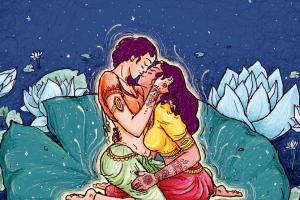Priya Dali first stumbled upon the story in academician Ruth Vanita's essay, Born to Two Mothers, The Hero Bhagiratha: Female-Female Love and Miraculous Birth in Hindu

While the queer narrative continues to be explored in India in myriad formats across subjects, one area that is usually steered clear of is religion and mythology. Priya Dali's Born To Two Mothers, The Hero Bhagirath, therefore, stands out in the milieu. The graphic narrative traces the legend of King Bhagiratha's birth, [as told in the Ramayana], who was born from the union of two queens."
ADVERTISEMENT
Dali first stumbled upon the story in academician Ruth Vanita's essay, Born to Two Mothers, The Hero Bhagiratha: Female-Female Love and Miraculous Birth in Hindu Texts. She had worked on the story while she was interning at Gaysi, an e-zine catering to the LGBTQ community, last year. Come September, the story will be launched officially as part of the 18-story mythology series that the zine will be putting out.
Bhagiratha's story has several versions, depending on how authors across regions approached the subject of two women in a romantic union. Vanita talks about a few versions in her essay from which Dali picked one to work with. "Some say Bhagiratha was born just to release his forefathers of a curse. There's a version that says he was born without bones, as a blob of flesh. I chose the version that has gods blessing the union, not because of the child that was to be born, but just for what it was — an act of love. The purity of the relationship is honoured. There's a point in the story where one of the queens tries to kill herself, because she is so confused, especially about how the child was conceived without a man. That's when the gods step in and stop her. They explain to her that it's not unnatural, but rather a blessing," says the illustrator.

Priya Dali
Dali's visual narrative links the legend to contemporary times, where a mother recounts the story to her son. "It was important to have a contemporary connect. So, we had a story within a story. Here, the mother returns from her trip to Varanasi, where she stumbled upon the tale, and narrates it to her son. We have kept some things open ended, wherein the son reflects on what he has heard, thereby extending the larger conversation," she tells us. It's interesting how Dali has incorporated the Ganga into the narrative. The illustrations are incorporated into a bottle. "It's a common practice for many to store the holy water of the Ganga in a container, as a sign of purification. Hence, I thought of using that to portray the purity of relationship between the two queens."
A few frames are risqué and Dali was clear that she did not want to hold back. "The idea is to share these stories [in mythology] in their truest form. If we downplay now, these aspects will forever remain hidden. Yes, some might consider it bold, and we live in tricky times. But, I've always believed that if you do it from the heart, and the story is powerful, how much ever one wants to hate it, they might not be able to. And, some of these stories are like that. We have not recreated anything here, we have only given existing stories a visual language," says the 22-year-old self-taught artist.
The lush visuals might remind some of the bright colourful ones, like those of Amar Chitra Katha. Interestingly, Dali never read any of those as a child; in fact most of her research on the subject of mythology began in her third year of design school in Bengaluru, for her final semester project, which was based on mythology. It was a happy coincidence that Gaysi too, was working on the same subject around the same time. Speaking of the visual language, Dali says, "Even though it has been created completely digitally, I like my works to have a hand-drawn feel, the 'hand error' as they call it. It's not the most perfect lines or the perfect colouring. I wanted them to have a soft rhythm, the colours not too jarring, but not dull either. It's a happy story and I wanted the visuals to spell it, making it as emotive as possible. Also, Vanita's essay is so powerful, that it just evokes certain visuals in you. I would pick her words and try to visually translate them."
Toggling with mythology on an unconventional vein could seem like inviting trouble in today's times and the risks are not lost on Dali. "My work revolves largely around LGBTQ subjects. I try not to preoccupy myself with thoughts of negative repercussions. Even at home, conversations are not always easy. In this story, for instance, my mum was trying to justify reasons for the union of the queens, not exactly accepting it. It is a process and I don't expect her to understand it all. But, she also understands the need for such stories to be told, and has, therefore, never tried to stop me."
Catch up on all the latest Mumbai news, crime news, current affairs, and also a complete guide on Mumbai from food to things to do and events across the city here. Also download the new mid-day Android and iOS apps to get latest updates
 Subscribe today by clicking the link and stay updated with the latest news!" Click here!
Subscribe today by clicking the link and stay updated with the latest news!" Click here!






